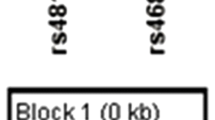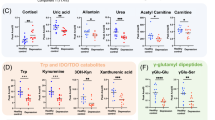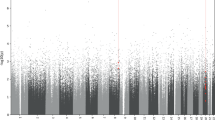Abstract
Several lines of evidence suggest that catechol-O-methyltransferase (COMT) may be associated with treatment response in depression. We conducted a study on 119 patients with treatment-refractory depression admitted consecutively for electroconvulsive therapy (ECT). The COMT high/high genotype leads to a higher enzyme activity and thus lowers dopaminergic activity in the prefrontal cortex. In the present sample, those homozygous to high-active allele of COMT responded significantly more frequently to ECT.
This is a preview of subscription content, access via your institution
Access options
Subscribe to this journal
Receive 6 print issues and online access
$259.00 per year
only $43.17 per issue
Buy this article
- Purchase on Springer Link
- Instant access to full article PDF
Prices may be subject to local taxes which are calculated during checkout

Similar content being viewed by others
References
UK ECT Review Group. Efficacy and safety of electroconvulsive therapy in depressive disorders: a systematic review and meta-analysis. Lancet 2003; 361: 799–808.
Millan MJ . Multi-target strategies for the improved treatment of depressive states: conceptual foundations and neuronal substrates, drug discovery and therapeutic application. Pharmacol Ther 2006; 110: 135–370.
Kapur S, Mann JJ . Role of the dopaminergic system in depression. Biol Psychiatry 1992; 32: 1–17.
Yoshida K, Higuchi H, Kamata M, Yoshimoto M, Shimizu T, Hishikawa Y . Single and repeated electroconvulsive shocks activate dopaminergic and 5-hydroxytryptaminergic neurotransmission in the frontal cortex of rats. Prog Neuropsychopharmacol Biol Psychiatry 1998; 22: 435–444.
Ishihara K, Sasa M . Mechanism underlying the therapeutic effects of electroconvulsive therapy (ECT) on depression. Jpn J Pharmacol 1999; 80: 185–189.
Lammers CH, Diaz J, Schwartz JC, Sokoloff P . Selective increase of dopamine D3 receptor gene expression as a common effect of chronic antidepressant treatments. Mol Psychiatry 2000; 5: 378–388.
Henry ME, Schmidt ME, Matochik JA, Stoddard EP, Potter WZ . The effects of ECT on brain glucose: a pilot FDG PET study. J ECT 2001; 17: 33–40.
Andrade C, Srinivasamurthy GM, Vishwasenani A, Prakash GS, Srihari BS, Chandra JS . High but not low ECS stimulus intensity augments apomorphine-stimulated dopamine postsynaptic receptor functioning in rats. J ECT 2002; 18: 80–83.
Lachman HM, Papolos DF, Saito T, Yu YM, Szumlanski CL, Weinshilboum RM . Human catechol-O-methyltransferase pharmacogenetics: description of a functional polymorphism and its potential application to neuropsychiatric disorders. Pharmacogenetics 1996; 6: 243–250.
Grover S, Mattoo SK, Gupta N . Theories on mechanism of action of electroconvulsive therapy. German J Psychiatry 2005; 8: 70–84.
Szegedi A, Rujescu D, Tadic A, Muller MJ, Kohnen R, Stassen HH et al. The catechol-O-methyltransferase Val108/158Met polymorphism affects short-term treatment response to mirtazapine, but not to paroxetine in major depression. Pharmacogenomics J 2005; 5: 49–53.
Arias B, Serretti A, Lorenzi C, Gasto C, Catalan R, Fananas L . Analysis of COMT gene (Val 158 Met polymorphism) in the clinical response to SSRIs in depressive patients of European origin. J Affect Disord 2006; 90: 251–256.
Gogos JA, Morgan M, Luine V, Santha M, Ogawa S, Pfaff D et al. Catechol-O-methyltransferase-deficient mice exhibit sexually dimorphic changes in catecholamine levels and behavior. Proc Natl Acad Sci USA 1998; 95: 9991–9996.
Fisman M, Rabheru K, Hegele RA, Sharma V, Fisman D, Doering M et al. Apolipoprotein E polymorphism and response to electroconvulsive therapy. J ECT 2001; 17: 11–14.
Huuhka M, Anttila S, Leinonen E, Huuhka K, Rontu R, Mattila KM et al. The apolipoprotein E polymorphism is not associated with response to electroconvulsive therapy in major depressive disorder. J ECT 2005; 21: 7–11.
Huuhka K, Anttila S, Huuhka M, Leinonen E, Rontu R, Mattila KM et al. Brain-derived neurotrophic factor (BDNF) polymorphisms G196A and C270T are not associated with the response to electroconvulsive therapy in major depressive disorder. Eur Arch Psychiatry Clin Neurosci 2007; 257: 31–35.
Anttila S, Huuhka K, Huuhka M, Rontu R, Mattila KM, Leinonen E et al. Interaction between TPH1 and GNB3 genotypes and electroconvulsive therapy in major depression. J Neural Transm 2007; 114: 461–468.
Livak KJ . Allelic discrimination using fluorogenic probes and the 5' nuclease assay. Genet Anal 1999; 14: 143–149.
Acknowledgements
This study was supported by the Medical Fund of Tampere University Hospital.
Author information
Authors and Affiliations
Corresponding author
Additional information
Duality of interest
We declare that we have no duality or conflict of interest.
Rights and permissions
About this article
Cite this article
Anttila, S., Huuhka, K., Huuhka, M. et al. Catechol-O-methyltransferase (COMT) polymorphisms predict treatment response in electroconvulsive therapy. Pharmacogenomics J 8, 113–116 (2008). https://doi.org/10.1038/sj.tpj.6500468
Received:
Revised:
Accepted:
Published:
Issue Date:
DOI: https://doi.org/10.1038/sj.tpj.6500468
Keywords
This article is cited by
-
Novel candidate genes for ECT response prediction—a pilot study analyzing the DNA methylome of depressed patients receiving electroconvulsive therapy
Clinical Epigenetics (2020)
-
The COMTval158met polymorphism is associated with symptom relief during exposure-based cognitive-behavioral treatment in panic disorder
BMC Psychiatry (2010)



